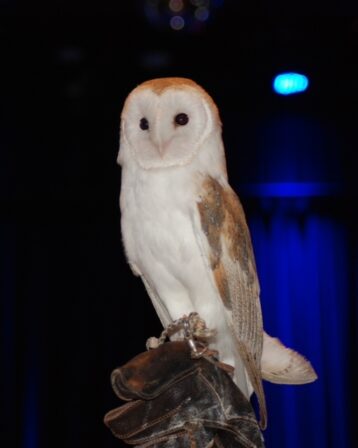Raptors with Nancy Conney
As I have said many times, the Mission Hills Garden Club continues to broaden my interests. When the San Diego Floral Association informed Garden Club members that Nancy Conney, founder and operator of Sky Hunters, a non-profit organization that rescues harmed raptors, would be speaking about her rescues at the Prado in February, I went to hear her. What a treat the day was.
Sky Hunters’ primary goal is to rescue sick and injured birds and then release them into the wild. The organization also focuses on educating the public. The February talk featured owls. The first owl she showed us was a tiny screech owl. Conney encouraged him to show his voice. It is not a screech; it is a pleasant purr-like chirp, much like a cat’s when greeting a loved one. Conney fluffed the top of his head into the little tufts commonly believed to be ears. These screech owls find the fluffed feathers sexy and arrange them as if they were members of a heavy metal band.
Since these animals are not pets, they are never named. While they are often much loved by their caretakers, they are treated with minimum handling. Conney explained how owls differ from other raptors. First, they use their hearing to track prey. Second, with non-rotating eyes in the middle of their faces, they need necks flexible enough to turn 270 degrees. (I just read in the New York Times that due to a skull full of special hearing mechanisms, the only place left for the eyes was in the center of their heads!)
The other owl visiting that day was a beautiful male barn owl. Barn owls’ hearing is particularly acute. Like all owls, their ears are asymmetrical with one side’s ear higher on the head and the other’s is lower. Their dish-shaped faces also help to direct sound to their ears. With these advantages, a barn owl can pinpoint a mouse rustling hundreds of feet away or hear a burrowing creature underground.
Barn owls have exceptionally hideous voices. Barn owlets scream in a hoarse, loud, rasping voice constantly. However, barn owl parents are blessed with ear flaps which shut out the sound of the screeching offspring. Conney showed us the ear slit and the closable flap. Because most birds lay an egg a day, the babies are different ages; someone is always hungry.
Being of different ages, they don’t all fledge (learn to fly) at the same time. This can create a problem, particularly if the nest or owl box is on a pole instead of a tree. A tree provides shade in summer and branches for rookies’ practice flights. Usually the ground beneath the tree is soft, cushioning an accidental tumble. A box on an isolated pole creates a built-in hazard for fledglings. There are no safety nets such as are found in trees.
However, if you find a baby bird on the ground, there is proper protocol to ensure the bird’s survival. First, does the bird have feathers? If it appears unharmed but naked, get a cardboard box in which you poke air holes, a towel or blanket and heavy gloves. A traumatized bird will usually bite with a beak that can rip its prey into bits. The towel is to confine the bird until you have him back in his nest. If the nest is too high up or you cannot see it, get a plastic basket used for berries and fasten it to the tree trunk. Place the bird in the tree. You may need to wrap a barrier below it to keep animals from climbing up to get the bird. Mom and Dad will find their baby and feed him with his siblings. Do NOT feed or pet the bird. Its parents know what is good for it to eat, and you do not. They also expect to feed their brood, sometimes as often as every 30 to 35 minutes. “Let the parents do their job,” she says. It is a wild creature that should not be “tamed.” Conney went on to say that it is a myth that the parents will reject the bird because of human odor. Most birds have little or no sense of smell (with the exception of vultures whose sense of smell is highly developed).
If the bird on the ground has feathers, it had a bad first flight. Its parents know where it is and will feed and care for it until it masters flight. An injured or sick bird must be taken to a rescue organization. Project Wildlife is on Sherman off Morena Boulevard where the old humane society once was. Again, wearing gloves and covering the bird with a towel or blanket, place it in a secure box and take it to the rescue people. They have access to veterinarians specializing in wild birds.
Conney continued by explaining that barn owls may breed two or three times a year, depending on the food supply. Like most birds, they are monogamous. Some species are monogamous but they only see their mates during courting, housekeeping, breeding, and raising the babies to adulthood. Then they take separate vacations. Conney thinks this is why the divorce rate is so low among birds.
Sky Hunters is open to the public on weekends from noon until 4 p.m. by appointment only. Call (619) 445-6565 for a reservation.
Due to Thanksgiving, November’s meeting will take place on November 13 from 6 to 8 p.m. We are having a catered holiday party featuring professional florist Frankie Hartwell (who used to work for Botanica), demonstrating festive Thanksgiving arrangements.
Category: Local News








